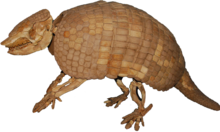

You can help expand this article with text translated from the corresponding article in German. (June 2022) Click [show] for important translation instructions. |topic= will aid in categorization.Content in this edit is translated from the existing German Wikipedia article at [[:de:Pampatheriidae]]; see its history for attribution.{{Translated|de|Pampatheriidae}} to the talk page. |
| Pampatheriidae
| |
|---|---|

| |
| Holmesina occidentalis | |
| Scientific classification | |
| Domain: | Eukaryota |
| Kingdom: | Animalia |
| Phylum: | Chordata |
| Class: | Mammalia |
| Order: | Cingulata |
| Family: | †Pampatheriidae Paula Couto 1954 |
| Genera | |
Pampatheriidae ("Pampas beasts") is an extinct family of large cingulates related to armadillos. They first appeared in South America during the mid-Miocene, and Holmesina and Pampatherium spread to North America during the Pleistocene after the formation of the Isthmus of Panama as part of the Great American Interchange. They became extinct as part of the end-Pleistocene extinctions, about 12,000 years ago.[2]
The placement of the Eocene genus Machlydotherium in the family is considered doubtful. The oldest undoubted member of the group is Scirrotherium from La Venta, Colombia, dating to the mid-Miocene.[2]
Pampatheres are believed to have attained a weight of up to 200 kg (440 lb). Like three-banded armadillos, and unlike glyptodonts, their armored shell was given some flexibility by three movable lateral bands of scutes.[3] The osteoderms (bony plates in the skin comprising the armor) of pampatheres were each covered by a single keratinized scute, unlike osteoderms of armadillos, which have more than one scute.[3]

A study of pampathere jaw biomechanics showed that their masticatory musculature was more powerful and more adapted for transverse movements than that of armadillos, leading to the conclusion that much of their diet was coarse vegetation. They are thought to have been primarily grazers, unlike armadillos, which are omnivorous or insectivorous.[3] The variation between species in the expression of adaptations for grinding coarse vegetation correlates with the aridity of their habitat; such adaptations are most pronounced in Pampatherium typum, which lived in the arid Pampas, and least pronounced in Holmesina occidentalis, which lived in humid lowlands.[4]
| Pampatheriidae |
|
|---|---|
This prehistoric mammal-related article is a stub. You can help Wikipedia by expanding it. |